
Pictured above is the Pope House on South Wilmington Street. Currently a museum run by the city and registered historic landmark, the house belonged to Dr. Manassa Thomas Pope, a doctor and prominent businessman in Raleigh who would later run for mayor in 1919. It is also the only African-American house museum in the state of North Carolina.
100 years ago, this block of South Wilmington Street was covered by homes and the Pope house fit in nicely. Today, it’s floating in an ocean of surface parking with high-rise office towers nearby.
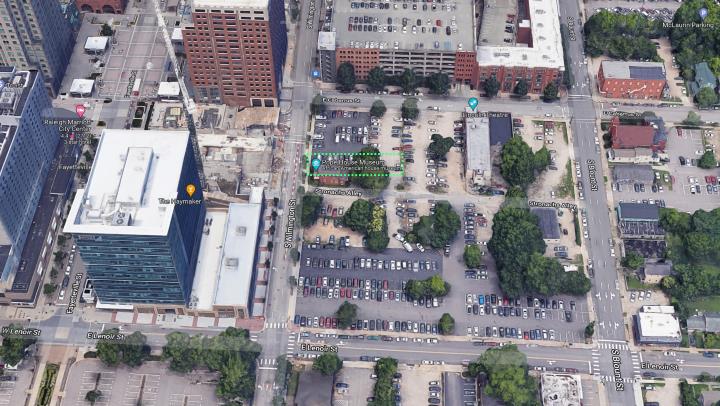
A collection of lots on the southern half of the block is currently going through a rezoning. (Z-1-22, pdf link) The request is to increase the height allowed from the current seven stories to a new limit of 20.
Construction in the area is taking its toll on the Pope House.
During a meeting with the Raleigh Historic Development Commission in March 2022, it was reported that construction from nearby Charter Square probably contributed to some structural damage to the house. To help with this rezoning case, it was asked if other construction techniques could be used that would not damage the historic structure.
The rezoning has not reached the city council for ultimate approval yet but it may be time to consider a serious move and uplift to the Pope House Museum.
A case NOT to move houses
I recognize that buildings and structures that remain on their original locations is a far-superior representation of the time that they once served. I can’t imagine what the 500 block of South Wilmington Street could have looked like with a variety of single-family homes. The Raleigh of the 1920s is practically another reality compared to today and at least for me, during my visit of the Pope House a few years ago, you could get a sense of it’s prominent location.
Dr. Pope’s house was close to East Hargett Street, or Black Main Street, which he and his family frequented. He also graduated from nearby Shaw University. You can kind of “travel back in time” and get a sense of the connectedness that his family had in the area.
If the house was moved a few blocks to the east, for example, placed between new construction homes of the 2020s, that history and sense of place, even if you have to really imagine it, is pretty much lost.
There are also practical issues such as major damage during a move, the cost of moving a house, and securing a new location. Think of the logistical challenges of moving a historic home through the streets of downtown Raleigh.
A case FOR moving houses
It just seems so simple. Move a house away from a site and you save it from demolition. We’ve done this before and it happens all over the country.
The house that once was a home may be reused as an office or even hotel. There is of course the risk and the cost but if a house is moved, it may stand for a hundred more years, continuing to tell its story.
Demolishing a house, or any structure, can also be seen as disrespecting the value that it currently brings. The materials and work that went into the house just vanish and end up in a landfill, most of the time anyway. To move a house, it saves that value and transfers it to another location. There’s a sense of sustainability here.
The List
When it comes to the Pope House, there are no plans to move it as of this writing. At the same time though, I did want to create a list of notable house moves around downtown Raleigh to kind of show that it’s not a far-fetched idea. If there is anything that I may have missed, let me know and we’ll get it added.
Guest House Raleigh
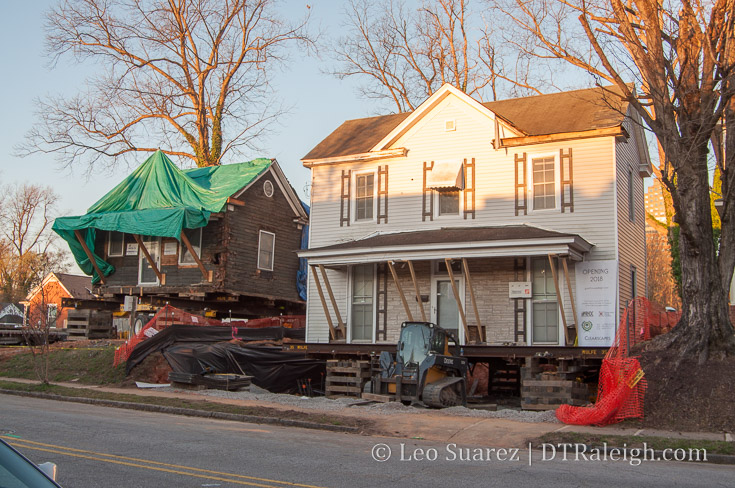
The boutique hotel, Guest House Raleigh, was originally located at 114 East Lenoir Street. On a cold Sunday in February 2017, along with its neighbor at 112 East Lenoir, the houses were moved to their current locations on Bloodworth Street.
For more, I’ll pass you over to an article in Walter Magazine as well as some great photos on the hotel’s Instagram page, the best being the one embedded below.
Merrimon-Wynne House
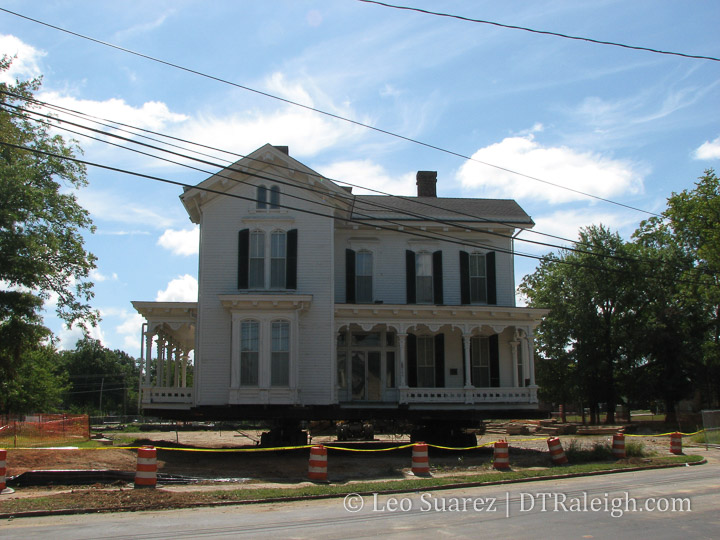
In 2008, the Merrimon-Wynne house was moved from it’s location on North Wilmington Street to its current location on Blount Street. It was only a two block move but the house has some considerable size and is one of the largest house moves to take place in Raleigh. It used to sit about where the Elan Apartments are today.
Seaboard Coast Line Railroad Building
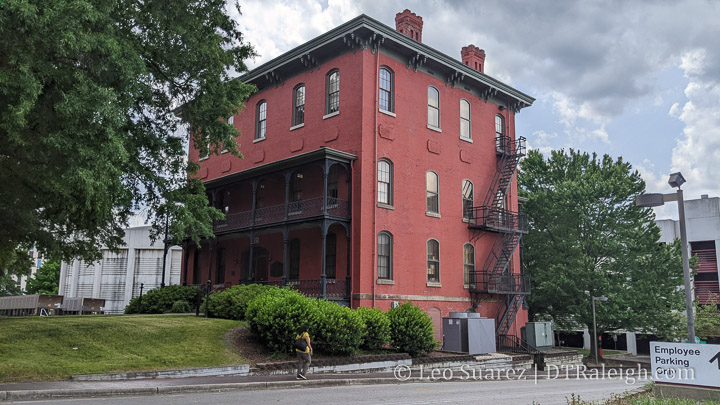
Probably the largest move to take place in downtown was that of the Seaboard Coast Line Railroad building shown above. The building was used as offices for the railroad for a long time and sat on the 300 block of Halifax street. Note, this street doesn’t exist anymore as the state government complex built over it all.
They did move the office structure to the west onto Salisbury Street sometime in the 1970s to where it sits today. More on that, with older photos, in this post on Goodnight, Raleigh.
Andrew Johnson Birthplace
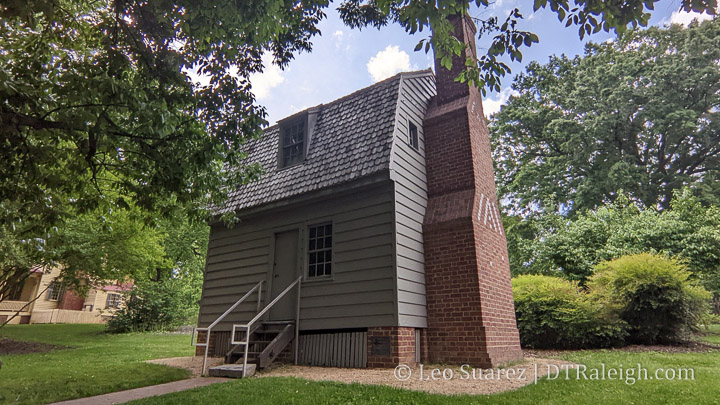
North of downtown is Mordecai Historic Park which contains a house that is the birthplace of President Andrew Johnson, born in 1808. It’s original location was somewhere on the 100 Block of Fayetteville Street and has been moved three times.
In 1975, it found it’s way to Mordecai Park where it still stands today. More on that story here.
Levin-Tarlton House

I actually have a post on this move. This house was moved off of 208 North Harrington Street before The Metropolitan apartments were built. The house currently sits at 414 New Bern Avenue. There is some fun video from Instagram in the post so do check it out.
Quick Mentions
- The Lincoln apartments on East Hargett Street was built on a block that only contained single-family homes. I talked to the developer of that project once and he told me that many of the homes there were actually moved instead of torn down. They sit in various spots south and east of that building.
- Several of the elegant mansions on Blount Street were actually moved from a spot nearby to their current location including the Capehart House and Lewis-Smith House.
- The Hume House and the Tucker House on Person Street are also not on their original locations.
Comments
Comments are disabled here. That's because we're all hanging out on the DTRaleigh Community, an online forum for passionate fans of the Oak City.
